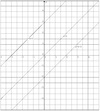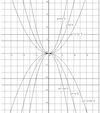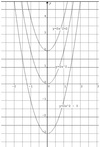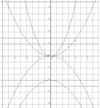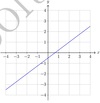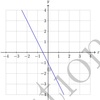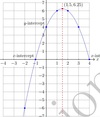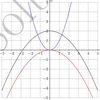Week 7 Complete Flashcards
(75 cards)
Linear Functions can be written in 2 ways
Standard form: 𝑎𝑥+𝑏𝑦+𝑐=0
Gradient-Intercept form: y=𝑚𝑥+𝑐
Write 𝑦=3𝑥+2 in standard form
𝑦=3𝑥+2 𝑦=3𝑥+2(−𝑦) 0=3𝑥−𝑦+2 or 3𝑥−𝑦+2=0
The gradient intercept form is so called because
if 𝑦=𝑚𝑥+𝑐 then the gradient of the line is 𝑚 and 𝑐 is the 𝑦 value where the line cuts the y axis.
slope is also called the gradient, which is calculated by?
rise/run **(y/x)**
linear function? form
y=mx+c 𝑦=(3/2)𝑥+(1)
dissect linear function form
y=(3/2)x+1 3/2 = gradient/slope = m 1 = y-int = c
y=(3/2)x+1
x intercept (at y = 0)
y=(3/2)x+1
x intercept (at y = 0)
0=(3/2)x+1
- 1 = (3/2)x
- 2/3 = x
y=(3/2)x+1
y intercept (at x = 0)
y=(3/2)x+1
y intercept (at x = 0)
y=(3/2)(0)+1 y=1
Graph 4𝑥+2𝑦−5=0
using the gradient and y-intercept.
4𝑥+2𝑦−5=0
2𝑦−5 =−4𝑥
2y/2= - 4x/2 +5/2
y= -2x + 2 1/2
m = -2 = - 2/1
(means graph will drop from left to right)
y-intercept = 2 1/2
i.e. (0,2 1/2)
Special Linear Equations
There are 2 straight lines that don’t quite fit the form of:
𝑎𝑥+𝑏𝑦+𝑐=0
or
𝑦=𝑚𝑥+𝑐.
-
𝑥=𝑎
e. g.
𝑥=3 (or 𝑥−3=0)
This means every point on this line, 𝑥 must be 3.
-
𝑦=𝑏
e. g.
𝑦=−2(or 𝑦+2=0)
Likewise, every point on this line 𝑦 must equal −2.
the line is positive if it rises from the:
and negative if it rises from the:
positive if Left to Right
negative if Right to Left


Another method for plotting the graph:
𝑦 = 3/2𝑥 + 1

Finding the equation of lines, given one point and the gradient.
Sometimes we know a line passes through a given point and we know the gradient, hence
we can find the equation of this line. This requires the rule:
𝒚 - 𝒚1 = 𝒎(𝒙 - 𝒙1)
where (𝑥1, 𝑦1) is the point the line passes through and 𝑚 is the gradient
Find the equation of the line that passes through (-3,4) with a gradient of 2
(-3,4) with a gradient of 2
(𝑥1, 𝑦1) ↔ (-3,4) (i.e. 𝑥1 = -3, 𝑦1 = 4)
𝑚 = 2
𝑦 - 𝑦1 = 𝑚(𝑥 - 𝑥1)
𝑦 - 4 = 2(𝑥 - (-3))
𝑦 - 4 = 2(𝑥 + 3)
𝑦 - 4 = 2𝑥 + 6
𝒚 = 𝟐𝒙 + 𝟏𝟎
Check: (because (-3,4) lies on this line, when we substitute in 𝑥 = -3 we should get 𝑦 = 4)
𝑦 = 2 × (-3) + 10
𝑦 = -6 + 10
𝑦 = 4
Also 𝑦 = 2𝑥 + 10 has a gradient of 2
Find equation of lines through 2 points.
If we know 2 points, we can find gradient, then use 𝑦 - 𝑦1 = 𝑚(𝑥 - 𝑥1)
Example: Find the equation of the line that passes though (-3,4) and (2, -1)
Solution: Although its not necessary, we may find it useful to quickly sketch the 2 points on
the Cartesian Plane. The gradient of the line joining 2 points (𝑥1, 𝑦1) and (𝑥2, 𝑦2)
is
m=y2-y1/x2-x1
(rise/run)

Parallel lines have the same gradient.
𝑦 = 3𝑥 - 2 𝑦 = 3𝑥 + 1 6𝑥 - 2𝑦 + 5 = 0
all have a gradient of 3 and when sketched will be parallel to each other
Find the equation of the line passing though (-4, -2) which is parallel to
3𝑥 - 5𝑦 + 8 = 0
Solution: We know parallel lines have the same gradient, so we need to find the gradient of
the given line.

𝑦 = 𝑚1𝑥 + 𝑐1
𝑦 = 𝑚2𝑥 + 𝑐2
product of gradient? perpendicular
𝑚1 × 𝑚2 = -1
because they are perpendicular, always -1
Find equation of line through (3,4) that is perpendicular to the line
𝑦 =2/5 𝑥 - 1

If 2 lines are not parallel to each other
then they will intersect each other at one point (𝑥, 𝑦)
only.
Point of Intersection or the Simultaneous
Solution.
There are 2 methods of finding this
unique solution, Substitution and
Elimination.
Solve
3𝑥 + 2𝑦 - 6 = 0
and
2𝑥 - 𝑦 + 10 = 0
by substitution
The substitution method entails rearranging one of the equations to get either 𝑥 or 𝑦 by itself
and then substituting that value into the other equation.
Solution:
3𝑥 + 2𝑦 - 6 = 0 –(1)
2𝑥 - 𝑦 + 10 = 0 –(2)
Number both equations, and make sure
both are in the form 𝑎𝑥 + 𝑏𝑦 + 𝑐 = 0
Upon inspection we can see that in equation (2) it can be easily rearranged to make 𝑦 the
subject.
(2)→ 2𝑥 + 10 = 𝑦 –(2a)
Now substitute for 𝑦 in equation (1)
(1)→ 3𝑥 + 2(2𝑥 + 10) - 6 = 0
3𝑥 + 4𝑥 + 20 - 6 = 0
7𝑥 + 14 = 0
7𝑥 = -14
𝑥 = -2
Now substitute for 𝑥 = -2 in (2a)
2𝑥 - 2 + 10 = 𝑦
6 = 𝑦
Answer:
𝒙 = -𝟐 𝒚 = **6**
The Elimination method involves
adding or subtracting the equations
Solve
2𝑥 + 7𝑦 = 16
and
3𝑥 - 6𝑦 = 2
by elimination
write each equation in standard form
2𝑥 + 7𝑦 - 16 = 0 –(1)
3𝑥 - 6𝑦 - 2 = 0 –(2)
We need to make the co-efficients of either 𝑥 or 𝑦 the same
(1) × 3 6𝑥 + 21𝑦 - 48 = 0 –(1a)
(2) × 2 6𝑥 - 12𝑦 - 4 = 0 –(2a)
(1a) – (2a) 33𝑦 - 44 = 0
33y = 44
y = 44/33 = 4/3
Sub for 𝑦 = 4/3 in either (1) or (2) to find 𝑥
in (1) 2x+7*4/3 -16=0
2x+28/3 - 48/3 = 0
2x=20/3
x=10/3
Answer:
x = 10/3
y = 4/3




